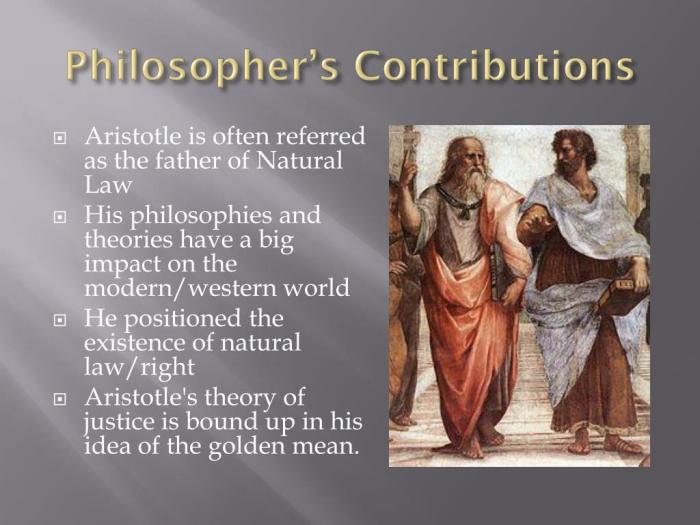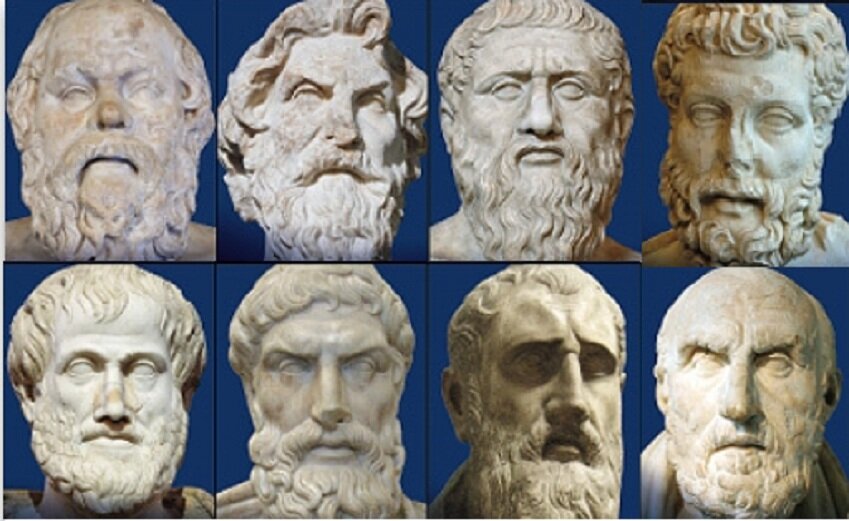
With famous philosophers and their contributions at the forefront, this paragraph opens a window to an amazing start and intrigue, inviting readers to embark on a storytelling journey filled with unexpected twists and insights.
Delve into the minds of influential philosophers, uncovering their profound impact on the world of philosophy and modern thought.
Famous Philosophers and Their Contributions
Philosophy has been shaped by the profound ideas of numerous influential thinkers throughout history. One such philosopher is Aristotle, known for his contributions to logic, metaphysics, ethics, and more. His works have had a lasting impact on various fields of study and continue to be studied and debated to this day.
Aristotle’s Key Contributions
Aristotle’s key contributions to philosophy include his development of formal logic, the concept of syllogism, and his exploration of metaphysics. He also delved into ethics, politics, and aesthetics, providing valuable insights that have influenced Western thought for centuries.
Influence of Aristotle on Modern Thought
- Aristotle’s emphasis on empirical observation and logical reasoning laid the groundwork for the scientific method, influencing modern scientific inquiry.
- His ethical theories, such as the concept of virtue ethics, continue to be relevant in contemporary moral philosophy.
- Aristotle’s ideas on politics and governance have informed political theory and practice throughout history, shaping modern systems of government.
Comparison of Aristotle and Immanuel Kant
While Aristotle focused on empirical observation and a systematic approach to knowledge, Immanuel Kant introduced the idea of transcendental idealism and the importance of reason in shaping human experience. Both philosophers made significant contributions to metaphysics and ethics, albeit from different perspectives.
Painting

In the world of art, paintings often serve as a visual representation of philosophical ideas and concepts. One famous painting that encapsulates this connection is “The Persistence of Memory” by Salvador Dali.”The Persistence of Memory” is a surrealist masterpiece that features melting clocks draped over various objects in a dream-like landscape. The painting explores the concept of time and memory, presenting a surreal interpretation of the fluidity and subjective nature of these elements.
Dali’s work challenges viewers to question their perception of reality and the significance of time in the grand scheme of existence.
Metaphysical Reflection
In “The Persistence of Memory,” Dali delves into metaphysical themes by depicting a world where time becomes malleable and subjective. The melting clocks symbolize the distortion of time, suggesting that it is not a fixed entity but rather a fluid and elusive concept. This challenges traditional notions of time as a linear progression and invites viewers to contemplate the nature of reality beyond conventional understanding.
Aesthetic Interpretation
From an aesthetic perspective, Dali’s painting showcases the beauty in the absurd and the surreal. The dream-like quality of the landscape and the distorted imagery create a sense of wonder and intrigue, drawing viewers into a world that defies logic and reason. The intricate details and vibrant colors add to the overall visual impact, inviting viewers to explore the depths of their imagination and question the boundaries of artistic expression.
Philosophical Influence
Salvador Dali’s philosophical beliefs, particularly his fascination with Freudian psychoanalysis and the subconscious mind, heavily influenced his artistic style. Dali’s interest in exploring the depths of human consciousness and the irrational aspects of the psyche is evident in “The Persistence of Memory,” where he blurs the lines between reality and fantasy. By incorporating elements of dream imagery and symbolism, Dali creates a painting that challenges viewers to confront their inner thoughts and emotions, reflecting the complexity of the human experience.
Performing Arts

Philosophical ideas often find their way into various forms of performing arts, enriching the experience for audiences and providing a platform for deeper contemplation.
Representation of Philosophical Ideas in Theater
In many theatrical performances, philosophical concepts are cleverly woven into the storyline to provoke thought and reflection among viewers. One notable example is the play “Rosencrantz and Guildenstern Are Dead” by Tom Stoppard. This absurdist play draws heavily from existentialist themes, questioning the nature of reality, the meaning of life, and the inevitability of death. Through the characters of Rosencrantz and Guildenstern, the audience is prompted to ponder their own existence and the role they play in the grand scheme of things.
Philosophy and Emotions in Musical Theater
Musical theater often explores the depths of human emotions, and philosophical ideas can serve as a backdrop to enhance the portrayal of these sentiments. One striking example is the musical “Les Misérables” based on the novel by Victor Hugo. The themes of justice, redemption, and the struggle for a better world resonate deeply with audiences, showcasing how philosophical concepts can elicit powerful emotions through storytelling and music.
Existentialism in Opera and Ballet
Existentialist philosophy, with its focus on individual freedom, choice, and the search for meaning in a seemingly indifferent universe, has made its way into the world of opera and ballet. One famous example is the opera “Carmen” by Georges Bizet, which explores themes of passion, fate, and the consequences of one’s actions. The character of Carmen embodies existentialist ideas as she navigates her own desires and confronts the realities of her choices, ultimately facing the consequences of her freedom.
Philosophy
Philosophy is the study of fundamental questions concerning existence, knowledge, values, reason, mind, and language. It plays a crucial role in shaping our understanding of the world and our place in it.
Existentialism
Existentialism is a philosophical movement that explores the individual’s freedom, responsibility, and search for meaning in a seemingly indifferent universe. It emphasizes the importance of personal choice and authenticity in defining one’s existence.
- Existentialism has had a significant impact on contemporary society by challenging traditional norms and encouraging individuals to question societal expectations.
- It has influenced fields such as psychology, literature, and art, fostering a deeper exploration of human emotions and experiences.
- Ancient philosophical teachings on existential themes, such as the works of Socrates and Stoicism, continue to resonate in today’s world by prompting individuals to reflect on their values and beliefs.
Photography
Photography is a powerful medium that captures moments, emotions, and stories through images. It has the ability to convey deep philosophical concepts and provoke thought through visual representation.
Analyzing a Famous Photograph
One famous photograph that embodies philosophical concepts is “Migrant Mother” by Dorothea Lange. This iconic image captures the hardships faced during the Great Depression, showcasing a mother with her children looking into the distance with a mix of worry and resilience. The photograph raises questions about human suffering, resilience, and the strength of the human spirit in times of adversity.
Photographer’s Worldview and Philosophical Beliefs
A photographer’s worldview and philosophical beliefs heavily influence their work. For example, a photographer who believes in the beauty of simplicity may focus on minimalist compositions, while a photographer who values authenticity may capture raw and unfiltered moments. These beliefs shape the photographer’s perspective and the stories they choose to tell through their photographs.
Connection Between Photography and Philosophical Themes
Photography and philosophical themes like identity and perception are closely intertwined. Photographs have the power to shape our perceptions of the world and ourselves. They can challenge our preconceived notions, evoke emotions, and prompt us to reexamine our beliefs. Through photography, we can explore questions of identity, reality, and the nature of existence in a visually compelling way.
Short Fiction
Short stories have been a medium for exploring philosophical themes in a condensed and impactful way. One renowned short story that delves into philosophical ideas is Franz Kafka’s “The Metamorphosis.”
Existentialist Themes in “The Metamorphosis”
Franz Kafka’s “The Metamorphosis” is a classic example of existentialist literature, as it portrays the protagonist, Gregor Samsa, waking up one day to find himself transformed into a giant insect. The story delves into themes of alienation, absurdity, and the search for meaning in a seemingly indifferent world. Gregor’s transformation serves as a metaphor for the existential crisis many individuals face when confronted with the absurdity of existence.
Use of Allegory in Short Stories
Short stories often employ allegory to convey deeper philosophical messages in a symbolic way. One notable example is Nathaniel Hawthorne’s “Young Goodman Brown,” where the journey of the protagonist through a dark forest represents the internal struggle between good and evil within oneself. By using allegory, authors can explore complex philosophical concepts in a more accessible and engaging manner for readers.
Visual Graphic Arts
Visual graphic arts encompass a wide range of creative expressions that convey meaning and provoke thought through visual elements. One famous graphic artwork that showcases profound philosophical symbolism is “The Persistence of Memory” by Salvador Dali.
Famous Graphic Artwork: The Persistence of Memory
“The Persistence of Memory” is a surrealist painting created by Salvador Dali in 1931. This iconic artwork features melting clocks draped over various objects in a dreamlike landscape. The painting challenges our perception of time and reality, inviting viewers to contemplate the fluidity of existence and the impermanence of the physical world.
- The melting clocks symbolize the relativity of time and the fleeting nature of life, prompting us to reflect on the transient and elusive quality of reality.
- The barren landscape in the background evokes a sense of desolation and introspection, inviting viewers to delve into the depths of their subconscious minds.
- Dali’s use of vibrant colors and surreal imagery creates a disorienting yet captivating experience, challenging conventional notions of logic and rationality.
Influence of Philosophy on Graphic Design
Graphic design, as a form of visual communication, can be deeply influenced by philosophical concepts such as ethics and aesthetics. Designers often grapple with questions of morality, truth, and beauty in their creative processes, seeking to imbue their work with meaning and purpose.
- Ethical considerations in graphic design involve issues of honesty, transparency, and social responsibility. Designers must navigate ethical dilemmas related to visual persuasion, manipulation, and the impact of their work on society.
- Aesthetic principles play a crucial role in shaping the visual language of design. Philosophical ideas about beauty, harmony, and proportion inform design choices, influencing the overall impact and effectiveness of a visual composition.
- By engaging with philosophical concepts, graphic designers can create visually compelling and intellectually stimulating work that resonates with audiences on a deeper level, transcending mere aesthetics and functionality.
Intersection of Visual Arts and Philosophy
The intersection of visual arts and philosophy offers a rich tapestry of ideas and perspectives, allowing artists and thinkers to explore complex themes and concepts through creative expression. Visual artworks serve as vehicles for philosophical inquiry, inviting viewers to contemplate the nature of existence, perception, and reality.
- Artists often draw inspiration from philosophical theories and movements, incorporating abstract concepts and metaphysical questions into their visual narratives.
- Philosophers, in turn, analyze and interpret visual artworks through the lens of their philosophical frameworks, uncovering layers of meaning and symbolism that enrich our understanding of the human experience.
- Through the synergy of visual arts and philosophy, new insights and interpretations emerge, challenging established beliefs and inspiring intellectual discourse on the nature of truth, beauty, and the meaning of life.
As we conclude our exploration of famous philosophers and their contributions, we reflect on the timeless wisdom and enduring legacy these thinkers have left behind, shaping our understanding of the world.
FAQ Overview
How did famous philosophers shape modern thought?
Famous philosophers like Socrates, Descartes, and Kant introduced revolutionary ideas that continue to influence modern philosophy and societal norms.
What is the significance of studying famous philosophers and their contributions?
Studying famous philosophers provides insights into the evolution of philosophical ideas and how they have shaped human thought and civilization.
Can the contributions of two renowned philosophers from different eras be compared?
Comparing the contributions of philosophers like Aristotle and Nietzsche allows for a deeper understanding of the diverse philosophical landscape across history.






